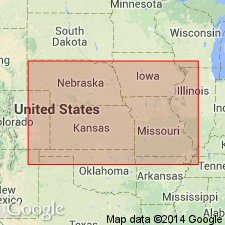
- Usage in publication:
-
- Corbin City member
- Modifications:
-
- Original reference
- Dominant lithology:
-
- Limestone
- AAPG geologic province:
-
- Cherokee basin
Summary:
Pg. 92, 97. Corbin City member of Drum limestone of Kansas City group. It is proposed to use Drum limestone as a formation name, and to recognize the light-blue [nonoolltic] lower bed as Cement City member and the upper bed of oolitic limestone as Corbin City member. The Corbin City (named for a locality just south of Cherryvale [Montgomery Co.]), is very local in development, but appears to be represented in Kansas City section by a thin bed of granular fossiliferous limestone spearated by a few inches of shale from main body of Cement City limestone. Age is Late Pennsylvanian (Missouri age).
Source: US geologic names lexicon (USGS Bull. 896, p. 520); GNC KS-NE Pennsylvanian Corr. Chart, sheet 2, Oct. 1936.
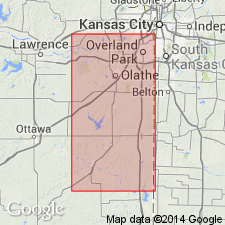
- Usage in publication:
-
- Corbin City limestone member
- Modifications:
-
- Areal extent
- AAPG geologic province:
-
- Forest City basin
Summary:
[See 1935 entry under Cement City limestone.]
Source: US geologic names lexicon (USGS Bull. 896, p. 520); GNC KS-NE Pennsylvanian Corr. Chart, sheet 2, Oct. 1936.

- Usage in publication:
-
- Corbin City limestone member
- Modifications:
-
- Areal extent
- AAPG geologic province:
-
- Cherokee basin
- Forest City basin
Summary:
Pg. 106-107. Corbin City limestone member of Drum limestone of Kansas City group. Rests disconformably on Cement City limestone member in southern Kansas. To southwest, west, and northwest of Coffeyville it is represented by limestone conglomerate. Thickness of member ranges from feather edge to 50+/- feet. Near Kansas City, Missouri, a limestone 1 foot or less thick, separated from Cement City limestone by a few inches of fossiliferous shale, is thought to represent Corbin City member. Age is Late Pennsylvanian (Missouri age).
Source: US geologic names lexicon (USGS Bull. 896, p. 520); GNC KS-NE Pennsylvanian Corr. Chart, sheet 2, Oct. 1936.
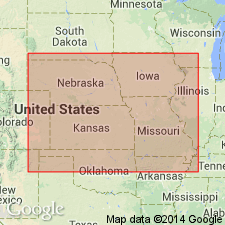
- Usage in publication:
-
- Corbin City limestone member
- Modifications:
-
- Overview
Summary:
Pg. 2030; 1949, Kansas Geol. Survey Bull., no. 83, p. 99-100. Corbin City limestone member of Drum limestone. Predominantly a cross-bedded oolite locally 40 feet or more thick. Disconformably overlies Dewey limestone member; underlies Chanute formation. Age is Late Pennsylvanian (Missourian).
Source: US geologic names lexicon (USGS Bull. 1200, p. 939).
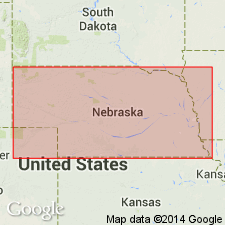
- Usage in publication:
-
- Corbin City limestone member
- Modifications:
-
- Areal extent
- AAPG geologic province:
-
- Cherokee basin
- Forest City basin
Summary:
Pg. 37. Corbin City limestone member of Drum limestone. Recognized in eastern Kansas and northwestern Missouri; unit absent in Nebraska. Age is Late Pennsylvanian (Missourian). Type locality stated.
Type locality: Corbin City, 2 mi south of Cherryvale, Montgomery Co., eastern KS.
Source: US geologic names lexicon (USGS Bull. 1200, p. 939).
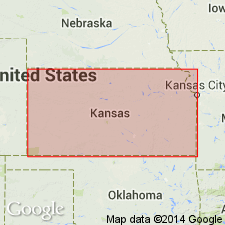
- Usage in publication:
-
- Corbin City Limestone Member
- Modifications:
-
- Overview
- AAPG geologic province:
-
- Cherokee basin
- Forest City basin
Summary:
(Paleozoic Era; Pennsylvanian System by J.M Jewett, H.G. O'Connor, and D.E. Zeller, p. 21-43; see also R.C. Moore and others, 1951, Kansas Geol. Survey Bull., no. 89.) Corbin City Limestone Member of Drum Limestone of Linn subgroup [informal] of Kansas City Group. Chiefly light-gray oolitic, crossbedded limestone that is abundantly fossiliferous. Best developed in vicinity of Independence (Montgomery County), where it is 50+ feet thick. Represented by a few feet of limestone conglomerate near Coffeyville, Montgomery County, and by 1 foot or less of chiefly oolitic limestone in the Kansas City area. Fossils are abundant in the thick oolitic facies. A few inches of shale that lies between the two limestone members of the Drum at some exposures is included with the Corbin City Member. In southeastern Kansas, seemingly rests disconformably on the Dewey Limestone. In vicinity of Cherryvale in Montgomery County, the oolitic limestone of the upper member fills depressions nearly 5 feet deep in the lower limestone. Age is Late Pennsylvanian (Missourian).
["Subgroup" not recognized as a formal stratigraphic rank term (CSN, 1933; ACSN, 1961, 1970; NACSN, 1983, 2005, 2021). Considered informal and should not be capitalized.]
Source: Publication.

- Usage in publication:
-
- Corbin City Limestone Member
- Modifications:
-
- Not used
- AAPG geologic province:
-
- Forest City basin
Summary:
Pg. C387. Corbin City Limestone Member of Drum Formation. In Missouri, rocks are now included in Cement City Limestone Member of Dewey Formation. [See entry under Drum Formation (Drum Limestone).]
Source: Publication.
For more information, please contact Nancy Stamm, Geologic Names Committee Secretary.
Asterisk (*) indicates published by U.S. Geological Survey authors.
"No current usage" (†) implies that a name has been abandoned or has fallen into disuse. Former usage and, if known, replacement name given in parentheses ( ).
Slash (/) indicates name conflicts with nomenclatural guidelines (CSN, 1933; ACSN, 1961, 1970; NACSN, 1983, 2005, 2021). May be explained within brackets ([ ]).

